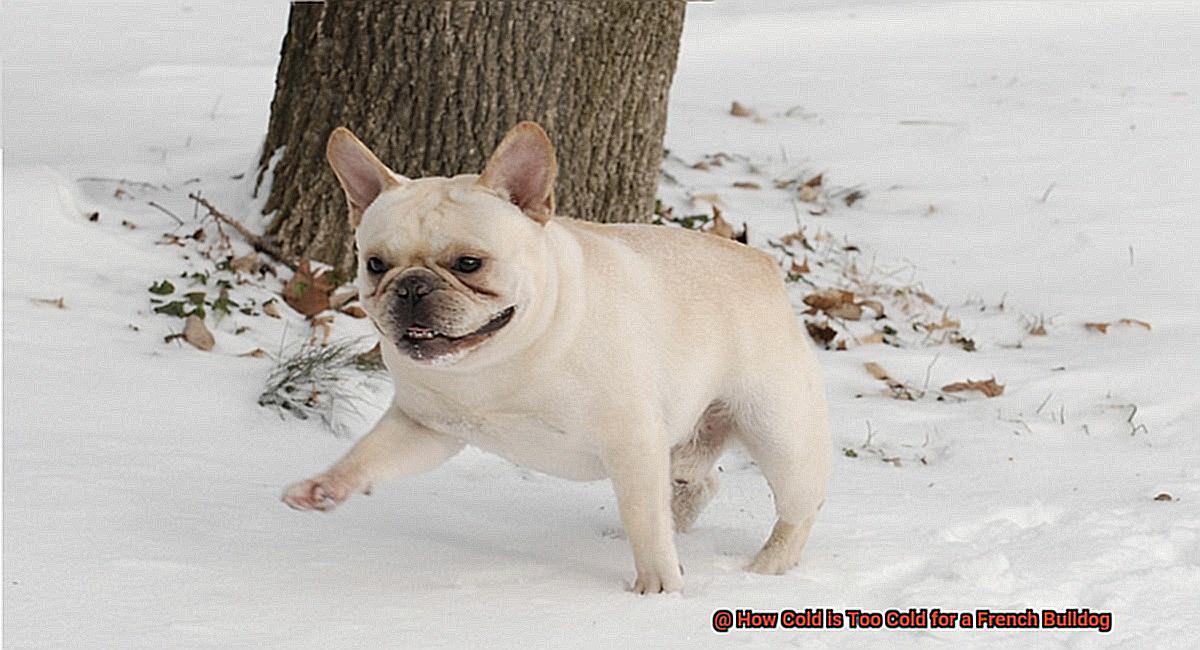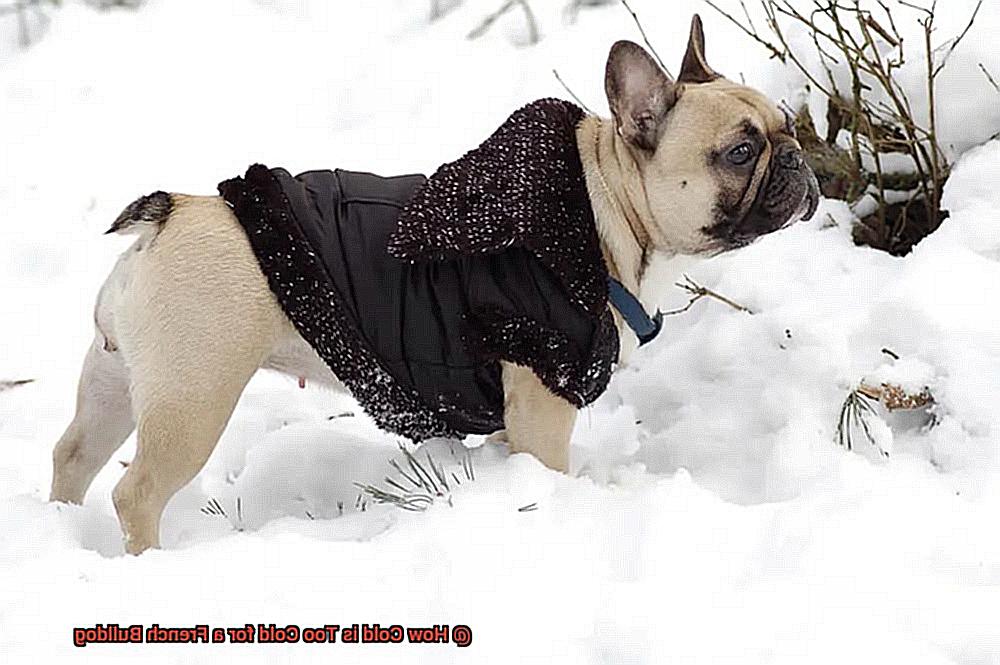How Cold is Too Cold for a French Bulldog?
With winter fast approaching, it’s time to start thinking about how our furry friends will fare in the chilly weather. While some breeds are perfectly content frolicking in the snow, others require extra attention and care to ensure they stay healthy and happy. French Bulldogs fall into the latter category.
With their adorable looks and affectionate nature, Frenchies have become a beloved breed around the world, particularly in colder climates. However, despite their popularity, these small dogs with low body fat percentages can struggle to regulate their body temperature when temperatures drop too low. This puts them at risk for serious health issues like hypothermia and frostbite.
So what exactly is too cold for a French Bulldog? That depends on several factors, including temperature, age, health status, and length of time spent outside. In this blog post, we’ll dive into the ideal temperature range for these precious pups and provide tips on how to keep them safe and comfortable during the colder months.
Whether you’re a seasoned Frenchie owner or considering adding one to your family, it’s crucial to understand how to properly care for your pet during winter. So grab a cup of cocoa (or hot tea if you prefer) and let’s explore everything you need to know about keeping your furry friend cozy all season long.
Cold Weather and French Bulldogs
Contents
French Bulldogs are undoubtedly one of the most adorable breeds out there, but their unique needs require extra attention, especially when it comes to dealing with cold weather. As a responsible pet owner, it’s crucial to understand how the cold can affect your furry friend and take necessary precautions to keep them safe and healthy.
Due to their short and thin coats, Frenchies are highly sensitive to cold weather. They are not built for extreme temperatures and can easily get chilly, which can lead to various health problems. This is why it’s crucial to monitor the temperature and protect your pet from harsh weather conditions.
So, how do you know if it’s too cold for your French Bulldog? Experts recommend avoiding temperatures below 50°F (10°C), but this can vary depending on your pet’s health, age, weight, and activity level. Keep a close eye on their behavior and body language to determine if they are uncomfortable.
Wind chill can make things even worse – if there’s a strong wind blowing, your Frenchie may feel much colder than the temperature suggests. So, it’s best to avoid taking your dog out on windy days or during storms.
When taking your French Bulldog outside during cold weather, make sure to dress them up in a warm coat or sweater. There are plenty of options available in the market that provide extra warmth and insulation for your pet. Don’t forget their paws – the cold ground can be uncomfortable or even painful for them. Consider getting some booties to protect their feet from the cold and ice.
It’s also important to ensure that your French Bulldog has access to a warm and comfortable environment indoors. A well-insulated home with a regulated temperature is vital to keeping your pet safe during colder months. Providing a warm bed, blankets, and heating pads can also help keep them cozy.
French Bulldogs require extra care when it comes to dealing with cold weather. As a pet owner, you must be aware of the signs of hypothermia and take necessary precautions to keep your furry friend safe and healthy during colder months.
How Cold is Too Cold for a French Bulldog?
After all, French Bulldogs may look tough on the outside, but their short and thin coats make them highly sensitive to the chill. So let’s explore the details and find out what you need to do to keep your furry friend warm and safe.
In general, French Bulldogs should not be exposed to temperatures below 32 degrees Fahrenheit for an extended period of time. Even though they have a thick coat of fur, it’s not enough to protect them from extreme cold temperatures. However, each individual dog is different and may have different tolerances for cold weather. Factors such as age, weight, and overall health can all play a role in how well a French Bulldog can handle the cold. Moreover, acclimation to cold weather can also impact their tolerance levels.

But how can you tell if your French Bulldog is too cold? There are certain signs to look out for that indicate your furry friend may be uncomfortable. These include shivering, whining or barking excessively, lethargy, and seeking warm places such as under blankets or near heat sources. If you notice any of these signs, it’s essential to take action to warm them up.
So what can you do to keep your French Bulldog comfortable in colder temperatures? One way is by dressing them in appropriate clothing such as sweaters or jackets. Not only will this help keep them warm, but it can also make them look super cute. It’s also crucial to provide them with a warm and cozy place to rest indoors, away from any drafts or cold surfaces. Regular exercise and movement can also help keep their bodies warm.

French Bulldogs are delicate creatures when it comes to cold weather. But by paying attention to their individual needs and taking proper precautions, you can help keep them warm and cozy during the colder months. Remember to watch for signs of discomfort, dress them in appropriate clothing, and provide them with a warm and cozy place to rest indoors. By doing so, you’ll be able to enjoy the winter season with your furry friend without any worries.
Factors That Determine the Temperature Tolerance of a French Bulldog
Here, I will elaborate on these factors to help you better understand how to keep your furry friend comfortable and safe in different weather conditions.
Firstly, as a brachycephalic breed with a short nose and flat face, French Bulldogs may find it challenging to regulate their body temperature in extreme heat or cold. However, they do have a higher tolerance for cold temperatures due to their thick coats and stocky builds.
The thickness of your French Bulldog’s coat also plays a significant role in their ability to tolerate cold temperatures. A thicker coat provides more insulation and warmth, while a thinner coat may not provide enough protection against the cold. It’s important to remember that excessive grooming or shaving can also affect their temperature regulation.

Age is another critical factor that affects a French Bulldog’s temperature tolerance. Older dogs may struggle with regulating their body temperature due to decreased mobility and metabolism. Puppies also have difficulty regulating their body temperature as they are still developing.
Additionally, your French Bulldog’s overall health is essential in determining their temperature tolerance. Dogs with underlying health conditions such as heart or respiratory issues may have a harder time regulating their body temperature in extreme temperatures.
As a responsible pet owner, it’s crucial to monitor your French Bulldog’s behavior and body language in different weather conditions.
Signs of discomfort or distress such as shivering or excessively panting should be taken seriously and addressed promptly.
Providing appropriate shelter and clothing during extreme weather conditions can also help ensure your furry friend stays comfortable and safe.
Wind Chill and Its Effect on Frenchies
Wind chill is essentially the “feels like” temperature, and it can be a significant factor to consider when determining whether it’s too cold for your Frenchie to be outside.
While Frenchies have a stocky build and thick coat that help them handle the cold, their short coats and small size make them more susceptible to extreme weather conditions than larger breeds with thicker coats. Additionally, their flat faces make it harder for them to regulate their body temperature in extreme temperatures.
When you’re in an area where the wind chill can drop to dangerous levels, it’s crucial to limit your Frenchie’s time outside and provide them with warm clothing or a coat to wear. Monitoring them closely for any signs of discomfort or distress is also vital. If you notice your furry friend shivering or acting lethargic, it’s time to bring them inside and warm them up immediately.

It’s important to remember that French Bulldogs are not built for extreme weather conditions and that wind chill can lead to hypothermia, frostbite, and other health issues. By understanding how wind chill works and taking necessary precautions, you can help keep your Frenchie safe and comfortable during the winter months.
It’s essential to keep an eye on your furry friend’s behavior and provide appropriate shelter or clothing when needed. By doing so, you’ll ensure that your Frenchie is healthy and happy all year round. So, always be vigilant about the wind chill factor before taking your Frenchie out for walks or playtime outside. Remember to dress them up in cozy jackets and keep them close by your side for warmth.
Tips to Keep Your Frenchie Warm in the Winter Months
Creating a Cozy Indoor Space for Your Frenchie
Winter can be a harsh season for our furry friends, especially for French Bulldogs who are not built for cold weather. Therefore, it’s crucial to provide your Frenchie with a warm and cozy indoor space.
A heated room, a comfortable bed with blankets, or a heated pet pad can make all the difference. Imagine coming in from the cold to a warm and welcoming space – your Frenchie will appreciate it just as much as you do.
Dressing Your Frenchie in Warm Clothing
Your Frenchie may look adorable in their natural coat, but when the temperature drops, they need some extra warmth. Investing in warm and comfortable sweaters or jackets will help keep them cozy during outdoor walks.
Don’t forget about their paws – they need protection too. Booties or paw wax can protect their sensitive paws from the cold ground.
Adjusting Your Frenchie’s Diet
Did you know that adjusting your Frenchie’s diet can help increase their body heat and keep them warm during the winter months? Foods that are high in protein and fat such as chicken, beef, and fish can boost their metabolism and keep them energized.
Additionally, make sure that they have access to plenty of fresh water throughout the day to prevent dehydration.
Providing Indoor Exercise
We all know how important exercise is for our furry friends, but outdoor activities during winter can be limited. Therefore, providing indoor exercise options is crucial to keeping your Frenchie active and healthy.
Try playing games like fetch or tug-of-war, or create an obstacle course using household items such as pillows or chairs. Not only will it keep them warm, but it will also prevent boredom and keep their minds stimulated.
Monitoring Your Frenchie’s Comfort
Just like humans, dogs can experience discomfort and distress during cold weather.

Therefore, it’s important to monitor your Frenchie closely for signs of discomfort or distress. If you notice any signs such as shivering, lethargy, or loss of appetite, it may indicate that your dog is too cold and needs immediate attention.
Bringing them inside to a warm and comfortable space is the best course of action. By keeping a watchful eye on your furry friend and addressing any issues promptly, you can ensure that they stay happy and healthy throughout the winter months.
In conclusion, keeping your French Bulldog warm during the winter months requires some extra effort, but it’s worth it for their comfort and well-being.
Creating a cozy indoor space, dressing them in warm clothing, adjusting their diet, providing indoor exercise options, and monitoring their comfort levels are all essential steps to ensuring their happiness and health during cold weather.
Conclusion
As winter approaches, our furry friends need extra attention and care, especially French Bulldogs. These adorable pups may have a thick coat, but they are highly sensitive to cold temperatures. To keep your Frenchie safe and comfortable during the colder months, it’s crucial to monitor their behavior and provide appropriate shelter and clothing.
Experts recommend avoiding temperatures below 50°F (10°C), but individual factors such as age, weight, and health status can impact a French Bulldog’s temperature tolerance. Wind chill can also make things worse, so it’s best to limit outdoor time on windy days or during storms.
Creating a warm indoor space with a cozy bed and blankets is essential for your Frenchie’s comfort. Dressing them in warm clothing like sweaters or jackets and protecting their paws with booties or paw wax can also help keep them snug during outdoor walks. Don’t forget to adjust their diet by including protein and fat to boost their metabolism and increase body heat.
Indoor exercise options are a great way to keep your Frenchie active while monitoring their comfort levels. Remember that every dog is different, so pay close attention to any signs of discomfort or shivering.
By prioritizing your pet’s well-being through understanding how cold is too cold for a French Bulldog and taking appropriate action, you can enjoy the winter season with your furry friend without any worries.




